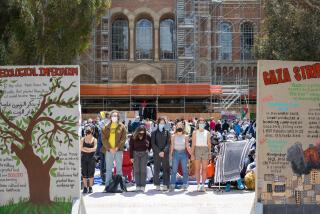POWs Reflect on Ordeal in ‘Return With Honor’
- Share via
The prospect of reliving the Vietnam War through the memories of American POWs sounds both grueling and profoundly depressing, but prizewinning documentarians Freida Lee Mock and Terry Sanders, with their stirring yet understated “Return With Honor,” offer the rare opportunity to feel some pride in our involvement in the drawn-out Southeast Asian conflict.
Doves and hawks alike can be deeply moved by the accounts of a group of American pilots shot down over North Vietnam and imprisoned for as long as six to eight years. They were subjected to torture, primarily by being bound by ropes that kept them in agonizing positions for long periods of time, along with isolation, beatings and brutal interrogations. But these men, now middle-aged, in response became determined to survive and not to betray their country.
They endured periods of suicidal despair, unspeakable loneliness and deprivation. They developed their minds as well as their bodies to the best of their abilities and devised myriad ways of strengthening their spirit for survival over the long haul. Whenever their captors finally succeeded in breaking them down they learned to give them misleading information, and whenever they were filmed or photographed or allowed to write home they used the opportunity to send coded messages with their eyes, their words and their gestures. You are simply too affected by the calm, matter-of-fact, even at times humorous, manner with which they recount their ordeal and how they endured it to be depressed.
Not surprisingly, such captured leaders as naval commanders Jeremiah (Jerry) Denton and James Stockdale were singled out by the North Vietnamese for the harshest treatment. (One of the most severely injured of the POW survivors was John McCain, the U.S. senator from Arizona, who as a lieutenant commander in the Navy was shot down in October 1967 and was not expected to live, yet refused an offer of an early release.)
One of the most impressive, among uniformly impressive individuals, is Navy Lt. John (Mike) McGrath, who also received exceptionally harsh treatment but who refuses to judge anyone who broke under pressure, saying that everyone has a breaking point. McGraw also dedicated himself to committing to memory everything he witnessed in prison so that he could draw it if he got out; the drawings he made in the month after his release punctuate this film dramatically. Latino and African American POWs also were singled out in an attempt to undermine their loyalty to their country.
McGrath’s drawings are among the many remarkable archival materials that Mock and Sanders, who won an Oscar for their “Maya Lin: A Strong, Clear Vision,” were able to draw upon in creating their exceptionally evocative documentary. Virtually every one of their witnesses is also seen in North Vietnamese newsreel footage, which invariably portrays the captives in humiliating circumstances, and the filmmakers repeatedly return to present-day views of such notorious prisons as the Hoa Lo--better known as the “Hanoi Hilton”--to convey just how primitive conditions were for the POWs.
As the war wore on with increasing unpopularity on the home front, the North Vietnamese made sure the POWs were subjected to American TV news reports of antiwar protests. But as one captive remarks, a North Vietnamese prison was no place for a U.S. serviceman to start considering the validity of America’s involvement in Vietnam. These were men who had agreed to live up to the U.S. military code of conduct and there is no question that their determination to do so against all odds was crucial to their ultimate survival.
Even so, the wife of Col. Tom Madison says she kept it quiet that her husband was a POW so that their young son wouldn’t be singled out for any ridicule. However, by 1969, Stockdale’s wife, Sybil, and a group of other wives of POWs at last defied government policy on keeping secret the plight of their husbands. Their actions, coupled with the death of Ho Chi Minh, improved conditions for the men, ending torture and isolation. Still, Lt. j.g. Everett Alvarez, the first U.S. pilot shot down and captured in the Vietnam War (Aug. 4, 1964) and the longest held in captivity (8 1/2 years), says that survival depended on erecting so many emotional shields that when liberation came, he at first could not allow himself to feel anything.
“Return With Honor” takes its title from the goal to which all these POWs strived with such resolve. Air Force Capt. Douglas (Pete) Peterson, held captive 6 1/2 years, was able literally to achieve that goal: In 1997, he became the first U.S. ambassador to the People’s Republic of Vietnam.
* Unrated. Times guidelines: descriptions of torture and other ordeals of POW life; too intense for children.
‘Return With Honor’
An Ocean release of a Playtone presentation presented by Tom Hanks. Producers-directors Freida Lee Mock and Terry Sanders. Written by Mock, Sanders and Christine Z. Wiser. Cinematographers Eddie Marritz and Sanders. Music by Charles Bernstein. Editor Greg Byers. Running time: 1 hour, 42 minutes.
Exclusively at the AMC Century 14, 10250 Santa Monica Blvd., Century City Shopping Center. (310) 553-5900.


